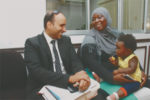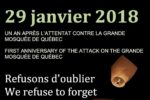This piece was written by Guest Contributor Asma T. Uddin.
Asra Nomani’s recent piece in Marie Claire, “My Big Fat Muslim Wedding”, underscored everything that is wrong with Marie Claire’s coverage of Islam and Muslim women. Nomani’s piece was a confused narrative at best, conflating culture with religion and individual bad experiences with larger truths about entire faiths. A story that should have been about Nomani’s conflicted path to love somehow became a treatise on Islam and love generally, suggesting that all Muslim men and women follow similarly conflicted, contradictory paths. Western ways of premarital intercourse and freedom to marry without regard to religious frameworks are presented as the higher moral ground.
 A similar sort of paternalism is rampant throughout Marie Claire’s treatment of Muslim women. Time and again, the image we see emerging from this magazine is that of Muslim women as sequestered, brainwashed, and victimized if by no one else than their own naïve, unknowing selves. Almost all of Marie Claire’s stories dealing with Islam or Muslims have to do with Muslim women either oppressed by or complicit in terrorism and extremism. Women who choose to embrace Islam are belittled, and Islam, in the process, is portrayed as attractive to only lost and desperate souls. On the flip side, Malika, the female jihadist in “Love in the Time of Terror” reflects the danger of Muslim female strength, while purportedly more respectable brands of strong females have spurned Islam to some degree or another (think Ayaan Hirsi Ali).
A similar sort of paternalism is rampant throughout Marie Claire’s treatment of Muslim women. Time and again, the image we see emerging from this magazine is that of Muslim women as sequestered, brainwashed, and victimized if by no one else than their own naïve, unknowing selves. Almost all of Marie Claire’s stories dealing with Islam or Muslims have to do with Muslim women either oppressed by or complicit in terrorism and extremism. Women who choose to embrace Islam are belittled, and Islam, in the process, is portrayed as attractive to only lost and desperate souls. On the flip side, Malika, the female jihadist in “Love in the Time of Terror” reflects the danger of Muslim female strength, while purportedly more respectable brands of strong females have spurned Islam to some degree or another (think Ayaan Hirsi Ali).
Consider, for example, Paul Cruickshank’s piece, “I Married a Terrorist”, the story of Maureen, a Belgian woman who met a non-practicing Muslim man at a bar and started dating him, their affair a whirlwind of partying. Somewhere amidst all the clubbing, Maureen began feeling empty, overwhelmed by her crazy ways. Her emptiness prompted curiosity about religion, and she began asking her boyfriend, Rachid, about Islam, of which he himself was ignorant.
This where the story about Maureen begins to reveal its anti-Islamic and sexist undertones; as Cruickshank describes Maureen’s mosque visits in search of knowledge, he notes, “[l]ike many young women with few career prospects, Maureen was in search of a sense of purpose, something to believe in.”
In that one sentence, Cruickshank reveals a number of troubling assumptions and biases: Women without careers are purposeless. Maureen’s curiosity and interest in Islam was necessarily rooted in her lack of career prospects, suggesting in itself that Maureen must be uneducated and even gullible.
The complexity of a spiritual quest and the attraction of Islam to rational minds are lost in this one simplistic sentence. The biases in that one sentence frame the story that follows and is repeated throughout it. Cruickshank goes on to describe Maureen’s conversion and how her excitement led to Rachid’s return to his religion. Rachid and Maureen end up turning to “fundamentalist” religious leaders for guidance, and one day Maureen decides to don the all-encompassing burqa on the basis of her conviction that Islam requires it.
As Cruickshank makes his way through Maureen’s stories–whether they be of her belief in the utility of the burqa or her disbelief that her husband, accused by Belgian police of aiding in the Madrid bombings, was implicated–he continues to reflect an astonishment, almost disbelief, that Maureen really believes what she’s telling him. There’s a sense that Maureen is blinded, almost brainwashed, by forces greater than herself, partly owing to female weaknesses and partly to the force of her fundamentalist beliefs and community.
Describing Maureen’s new husband, Ayoub, as a “moderate” Muslim – as reflected, apparently, by his easy-going personality and clean-shaven face – Cruickshank writes, “But despite Ayoub’s positive influence, traces of Maureen’s old views linger.” Because Maureen “refuses to describe her years wearing the burka as a mistake”, the reader gets the idea that Maureen doesn’t really know what is right or wrong, or what type of influence a scary, oppressive Islam had on her.
While “I Married a Terrorist” emphasizes the victimization of Muslim women by their own naïveté, many of Marie Claire’s other stories on Islam repeat the mantra over and over again that Muslim women need to be saved by greater, external forces, most often Islam itself. Admittedly, there are social conditions in the Muslim world that affect women adversely and need to be addressed, but Marie Claire’s treatment of these topics lacks in nuance and complexity, leaving the reader to pity Muslim women simply for their being Muslim.
Consider Jan Goodwin’s, “Honor Suicides in Turkey”. According to Goodwin, as a response to more stringent laws against honor killings (apparently initiated merely so that Turkey can prove itself worthy of admission into the EU) many families in Turkey are foregoing honor killings by asking women to commit suicide instead–thus the term, “honor suicide”. Nowhere in her piece does Goodwin discuss cultural factors, or the fact that honor killing occurs among some minority communities in Turkey rather than being a mainstream phenomenon. Instead, honor killings and suicides are clumped into the same group as headscarves and female illiteracy, the entire group being symptomatic of Turkey’s Islamist government. Muslim women are the losers in this country, all because of their and their country’s Islam.
There are thus multiple levels of victimization expressed in Marie Claire’s coverage of Muslim women, ranging from self-victimization (Islam as the answer for desperate, lost souls and only those souls), to falling prey to female weaknesses (Islam as attractive to only stupid, career-barren women), to being the inevitable victim of the ominous Islam of one’s family, society, and government. All of this adds up to Marie Claire’s distorted view of Muslim women.


